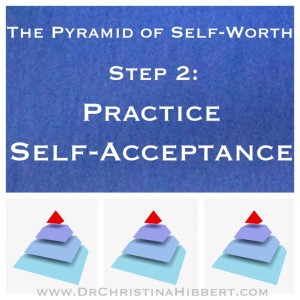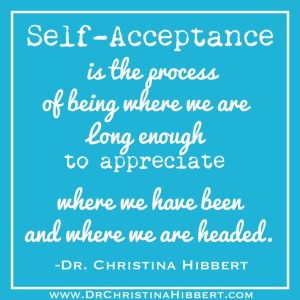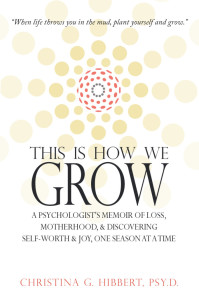
12 Mar “The Pyramid of Self-Worth” Step 2–Practice Self-Acceptance (& video)
 “Because one believes in oneself, one doesn’t try to convince others. Because one is content with oneself, one doesn’t need others’ approval. Because one accepts oneself, the whole world accepts him or her.” ~Laozi (Lao-Tsu)
“Because one believes in oneself, one doesn’t try to convince others. Because one is content with oneself, one doesn’t need others’ approval. Because one accepts oneself, the whole world accepts him or her.” ~Laozi (Lao-Tsu)
So far we have discussed how The Pyramid of Self-Worth can help you feel your true worth, and then how Self-Awareness is the first layer of the pyramid, or the first step. Today, we focus on layer two—Self-Acceptance.
Step 2: Practice Self-Acceptance
Once you can see all of you and how you are in this world (Self-Awareness), it’s time to work on accepting it. Now, I know that this can be one of the hardest steps for many people, especially women, but it’s also one of the most important. It’s important because, until you learn to accept yourself, you will never feel good enough. You will continue to battle against yourself, holding yourself back and preventing love. You don’t want that, do you? I didn’t think so.
Why is Self-Acceptance so hard?
Years ago, as I developed and started using The Pyramid of Self-Worth in my psychology practice, I was surprised to find how many people struggled with self-acceptance. After we had been working on self-awareness for a while I would ask my clients, “Can you accept the things you’ve discovered about yourself now?” I’m not sure why I expected that in seeing who they really were, they would naturally then accept who they were. Over and over I would hear things like, “I see it, but I don’t know how to accept it.”
I was also surprised to find that people (my clients, friends, and myself included) struggled more to accept their strengths than weaknesses. “People always say I’m a giving person, but I don’t feel like I give enough,” they’d say. Again, I wondered how to help someone feel something they’d never felt before.
Psychologist Carl Jung once said, “The most terrifying thing is to accept oneself completely.” Why is this so? What is so terrifying about seeing and accepting the truth? This is a question which can only be answered individually, but there are a few things I think make self-acceptance hard:
- For one, we aren’t sure how to accept ourselves. We fight with ourselves, trying to protect ourselves, without even knowing we’re doing it. Instead, we must learn to give up the fight, and to submit to self-acceptance.
- Some mistakenly think self-acceptance is “bragging” or “selfish,” and may fear what others think if they accept who they are. This is a case of misunderstanding self-acceptance. Self-acceptance isn’t saying, “I’m better than others.” It’s simply saying, “I see who I am right now, and I embrace it.”
- Finally, fear gets in the way of self-acceptance. We may fear that, in accepting, we agree with how we are—that accepting means we plan to stay that way. Some are afraid because to them, self-acceptance requires us to change, and certainly change can be scary and challenging. Niether of these is true. It is up to us if we choose to change the things we accept or not, but one thing is certain: we cannot make any change, or choose to grow, until we first accept how things are right now.
Watch this 3-Minute Therapy video on my YouTube channel: “Feeling Self-Worth: Step 2, Self-Acceptance.”
[stream provider=youtube flv=http%3A//www.youtube.com/watch%3Fv%3DiP2doWpikHk img=x:/img.youtube.com/vi/iP2doWpikHk/0.jpg embed=false share=false width=640 height=360 dock=true controlbar=over bandwidth=high autostart=false responsive=16:9 /]
What is self-acceptance?
To me, self-acceptance is the process of being where we are long enough to appreciate where we have been and where we are headed. It is an end to the pursuits of “self-esteem” and “trying to be something or someone,” for self-acceptance allows us to simply be who we really are.
At this moment, you are how you are. You feel what you feel. You’ve done what you’ve done. Your circumstances are your circumstances, and all of these must be accepted. Some definitions of the word, “accept,” include: to come to terms with something; to process something; to receive for review. Accepting yourself, therefore, means you are ready to come to terms with yourself.
If you’ve been working on Step 1, Self-Awareness, then you’ve seen some of your strengths and weaknesses—things you love about yourself and things you do not love. With self-acceptance, it’s time to process what you have seen, and to receive it for review. Review implies you can change that part of you if you choose, but only after you’ve accepted it. It’s saying, “I definitely have a quick temper (deep breath). Ok. I accept that is how I am now. I would, however, like to work on that.” Or, it’s saying, “I am really great at helping people feel loved. I really like that about me, and I want to share it.” You don’t have to suddenly like what you’ve seen or even want to change it; you simply have to accept that it is.
love about yourself and things you do not love. With self-acceptance, it’s time to process what you have seen, and to receive it for review. Review implies you can change that part of you if you choose, but only after you’ve accepted it. It’s saying, “I definitely have a quick temper (deep breath). Ok. I accept that is how I am now. I would, however, like to work on that.” Or, it’s saying, “I am really great at helping people feel loved. I really like that about me, and I want to share it.” You don’t have to suddenly like what you’ve seen or even want to change it; you simply have to accept that it is.
How to Practice Self-Acceptance: 3 Keys to Keep in Mind
1) Self-acceptance, at its core, is a choice. It’s a decision we make about ourselves. When I fail to accept myself, only I stand in my way. I choose to hold myself back because I simply cannot let go and let the way things are be “okay” with me. Do you understand the power of what I’m saying? It is in our head. It is up to us. Self-acceptance is our choice.
2) Self-acceptance is unconditional. It’s not that we accept what we like and reject what we do not. That’s what gets us into self-esteem trouble in the first place. No. Self-acceptance is an “all-in” deal. It means you are willing to let go of judgment and let things be as they are. It does not mean you’re giving up or giving in. In fact, the opposite is true. As you accept all things unconditionally, you open the door to true personal growth and development.
3) Self-acceptance is a process. It can feel like a huge thing—accepting yourself as a whole. Some are able to put all the pieces together and say, “This is how I am, and I accept me,” while others struggle to accept event he smallest piece. Though some people are able to accept all parts of themselves in one motion, for most of us, it’s not that quick or easy. For most, self-acceptance is a day-by-day, moment-by-moment process. As new traits, behaviors, and qualities in us arise, we find ourselves needing to accept them once again. In many cases, I’ve found, it’s most helpful to begin by accepting the small pieces as they come. As you become aware of a part of you–of a trait or ability or weakness–you can choose to accept it. Then, you can choose to accept the next thing you see. It can feel less overwhelming this way, yet still leads toward the eventual goal of complete self-acceptance. Some will likely be difficult to accept, but with time and work, the process of self-acceptance will cleanse and free you.
Bottom line…
Self-Acceptance is a daily—sometimes moment-by-moment—choice we make. It is a lifelong process, and it is unconditional. As we work to accept who we are, we open ourselves up to self-love (which we’ll talk about next time). As we accept who we are, we begin to feel our true potential and the worth of our precious soul.
Build Your Sense of Self-Worth
Self-Accptance Tools
1) Ask yourself the following questions. They will help you better understand how accepting you are, and what might be holding you back.
- What is most authentic about you?
- What is your greatest fear?
- What do you most fear people will find out about you?
- What do you wish people knew about you?
- When do you feel most truly yourself?
- Who are you without your mask on, without your “persona,” without your ego?
- What gets you in touch with your spirit?
- What makes you feel alive?
2) Choose to accept what you see in yourself today. When a trait pops up, take deep breath, then say, “I accept this about myself.” You don’t have to love it or feel anything about it, and you certainly don’t have to judge what you see. Simply choose to accept–bit-by-bit.
Leave a comment, below, and let us know…
How do you feel about self-acceptance? Is is hard for you? If so, what holds you back? If not, what helps you accept yourself?
Be sure to check out Dr. Hibbert’s Amazon Bestseller, This is How We Grow–
available now on Amazon.com!
Join my This is How We Grow Personal Growth Group!
FREE. Online. Growth. What more could you ask for?
Don’t miss a thing!
SUBSCRIBE, just below, “like” my Facebook pages (Dr. Christina Hibbert; This Is How We Grow), and follow me on Twitter,Pinterest, & Instagram!
You may manage your subscription options from your profile
Related Posts/Articles


Dr. Christina I wanted to ask, does acceptance more relies when you think more in neutral position about ‘bad’ or uncomfortable emotions or with an intention that this emotion is helping you ? Because some doctors saying you must not only stop ignoring your emotions thinking that they are bad, but take advantage of them, cause they have a purpose in helping you. What do you think about it ?
You see the biggest trick learning to approach acceptance, that people usually tend to avoid negative emotions subconsciously or by instincts and being in panic ‘label’ them looking for a quick fix.
Thanks
Ups I am sorry I wanted to mention and edit, that if you look not only from neutral position, but that emotion is helping you, emotion logically becomes like your ally (who give you right signals), but not anymore neutral (come and go aspect). These are my thoughts and questions 🙂
Hello Daniel. Thank you for all these excellent thoughts. I agree when we tune in to emotions–even the “negative” ones–they can help us understand what we need and receive it. I also agree people attend to avoid “negative” emotions, but really emotions aren’t “good” or “bad.” They are neutral by nature. It’s how we perceive them and the label we give them that make them “good” or “bad.” They are there to help us process events in our lives, and we can learn much from our emotions, for sure! 🙂
And for example before feeling and saying that painful emotion is ok, it’s natural or normal in human emotional spectrum to feel, foremost I believe you must understand clearly and feel that it’s not SHAMEFUL. If you say it’s ok, it’s natural to feel this way and you skip that step, I believe you still can deceive yourself from embodying fully emotion, there still can be defenses.
There are so many from the first sight small, unseen nuances and tricks that it can change or affect the whole ‘game’, prohibit from full effect in healing. You must be enough aware 🙂
Wow I have written a lot. But it’s very interesting topic 😉
I got stumped on the following question:
Who are you without your mask on, without your “persona,” without your ego?
I’m not sure how to figure out who I am without my ego. How do I figure this out?
This is a fabulous question–one I believe most of us struggle with at some point or another. I think the answer begins with being willing to sit still and “be” for a while, to let the mask slip off and little-by-little discover who is really there underneath it. We all have parts of our true selves that shine through even in our masks, but we will never see or feel who we truly are until we give ourselves the opportunity to show up and be seen. Yes, this requires great vulnerability. But in great vulnerability lies great strength.
I was wondering when you will do the last two videos of the self worth pyramid 3 minute session?